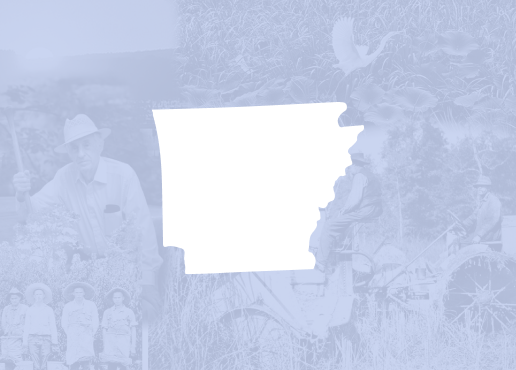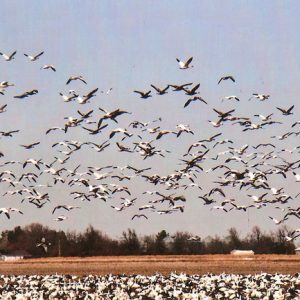calsfoundation@cals.org
Mississippi Flyway
The Mississippi Flyway is one of four loosely defined routes used by some species of migratory birds as they travel each autumn from breeding areas in northern North America to wintering sites in the southern United States, Mexico, and Central and South America, and back again in spring. Other North American flyways are the Atlantic, to the east of the Mississippi Flyway; the Central, through the Plains states; and the Pacific, west of the Rocky Mountains.
In northern latitudes, summer brings long days and abundant insects and other invertebrates for food, conducive to nesting success for birds. Winter, however, means harsh weather conditions, the disappearance of invertebrates, and frozen lakes and rivers. As a result, most birds nesting in the far north travel south each autumn to spend the winter in mild climates where adequate food is available.
Birds nesting across much of arctic North America and central Canada travel along the Mississippi Flyway into the north-central United States, generally following the Mackenzie, Missouri, Mississippi, and Ohio rivers to concentrate in the lower Mississippi River Valley. Depicted on a map, this pattern creates the shape of a giant funnel, with the lower Mississippi River as the spout. Some birds spend the winter in the Gulf Coast states, while others fly across the Gulf of Mexico or travel through Texas and Mexico to more-southerly wintering grounds.
Considering bird migration routes in terms of flyways is of importance primarily when discussing waterfowl (such as ducks and geese) and shorebirds (such as plovers and sandpipers), which are often dependent on wetlands for feeding and resting areas. The concept of flyways is less relevant in relation to the migration routes of songbirds such as flycatchers, thrushes, warblers, and sparrows. These species migrate mostly at night, when geographical landmarks such as rivers and mountain ranges are of less importance, and move in broad waves rather than concentrating along narrow corridors such as river valleys.
The recreational and economic value of waterfowl hunting has been the main incentive for the continuing emphasis on and study of bird flyways. It became apparent early in the twentieth century that hunting seasons and bag limits for ducks and geese had to be coordinated among wildlife agencies to prevent overhunting and to maintain healthy populations of migratory game birds. These efforts, which bring together entities such as the U.S. Fish and Wildlife Service, the Canadian Wildlife Service, and state game commissions, were organized regionally to correspond with the four North American flyways. Arkansas, for example, is administered by the Mississippi Flyway Council, organized in 1952 and including representatives of the Arkansas Game and Fish Commission. Using reports from field biologists on the breeding success of ducks and geese in the northern states and Canada, the Mississippi Flyway Council makes recommendations on the length of hunting seasons and the number of various species that can be killed by hunters each year.
The primary impact of the Mississippi Flyway in Arkansas lies in the vast number of ducks that winter in the state, traveling from nesting grounds as far away as Alaska and Canada’s Yukon Territory. The population of mallards in North American is estimated at around eight to ten million, and about forty percent of the continental wintering population is found in the lower Mississippi River Valley. The complex of wetlands in the Cache River, Bayou DeView, and lower White River areas of Arkansas has often been called the single most important wintering area for mallards in North America. Duck hunting, mainly for mallards, brings thousands of hunters into the eastern part of Arkansas each winter, creating the basis for a recreational industry that encompasses duck clubs, hunting guides, outdoor-equipment retailers, and associated lodging and restaurant services; this industry has been valued at more than $100 million annually.
Although Arkansas has no ocean shoreline, each spring and fall the state hosts many species of shorebirds as they travel to and from nesting areas in prairie wetlands and Arctic tundra and wintering sites on the Gulf of Mexico and farther south.
The use of flyways affects the distribution of other bird species, as well, though not as dramatically as is the case with waterfowl and shorebirds. The Cape May warbler nests across much of Canada yet is rarely seen in Arkansas because it follows the Atlantic Flyway on migration to and from its winter range on Caribbean islands. By contrast, the Tennessee Warbler, with a similar breeding distribution, is abundant in Arkansas in the spring as it flies across the Gulf of Mexico to the central Gulf Coast and travels northward through the central United States, generally following the Mississippi Flyway, and in the fall on its return flight. The bobolink, a small bird in the blackbird family, is common in Arkansas on its northbound spring migration but much less common in the fall, when most of the population flies southeastward to Florida before crossing the Caribbean to South America.
For additional information:
Division of Migratory Bird Management, U.S. Fish and Wildlife Service. http://www.fws.gov/migratorybirds (accessed March 9, 2022).
James, Douglas A., and Joseph C. Neal. Arkansas Birds: Their Distribution and Abundance. Fayetteville: University of Arkansas Press, 1986.
Mississippi Flyway Council. https://wildlifemanagement.institute/conference/mississippi-flyway-council-2 (accessed March 9, 2022).
Proctor, Noble S., and Patrick J. Lynch. Manual of Ornithology: Avian Structure and Function. New Haven: Yale University Press, 1993.
Mel White
Little Rock, Arkansas
 Environment
Environment Wapanocca National Wildlife Refuge
Wapanocca National Wildlife Refuge Mississippi Flyway
Mississippi Flyway 




Comments
No comments on this entry yet.